E2M Research: Shawn (April 2024)
The Restaking track represented by EigenLayer has received great attention and has become one of the hottest directions in Ethereum. E2M Research has also conducted many discussions on EigenLayer. EigenLayer extends ETH security to other applications on the blockchain network, while bringing additional benefits to participating ETH or LST holders.
Similarly, Babylon allows Bitcoin users to stake BTC to enhance the security of the PoS network, improve network security while earning revenue, and maintain Bitcoin self-custody. Since the Bitcoin mainnet cannot support complete smart contracts, Babylons architecture design and application scenarios are very different from EigenLayer. Anurag Arjun, former founder of Polygon and founder of Avail, also said on social media that Babylon is seriously underestimated compared to projects like Eigenlayer. It will suddenly gain momentum at some point, which will be a major unlocking of the BTC ecosystem.
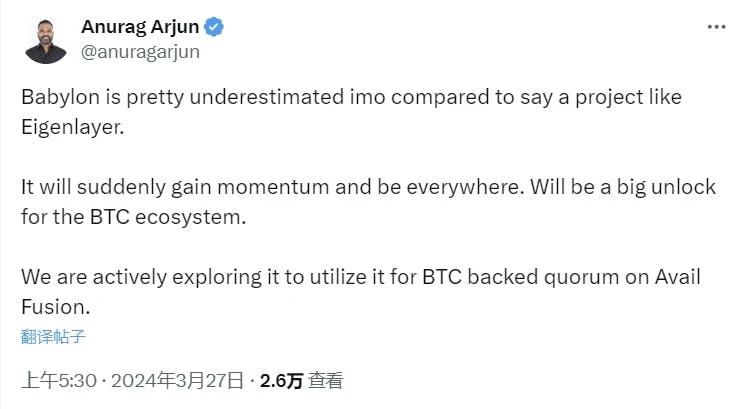
This article hopes to gain a deeper understanding of the similarities and differences between the two projects by comparing them in various aspects.
About Babylon
Babylon is a set of shared Bitcoin security protocols. Currently, it consists of two protocols:
Bitcoin Timestamp: This protocol sends a concise and verifiable timestamp of any data (such as a PoS blockchain) to Bitcoin
Bitcoin Staking: The protocol allows Bitcoin assets to be staked in a trustless (and self-custodial) manner to provide economic security for any decentralized system.
Bitcoin Timestamp Protocol
First is the structure diagram of the Bitcoin timestamp protocol:
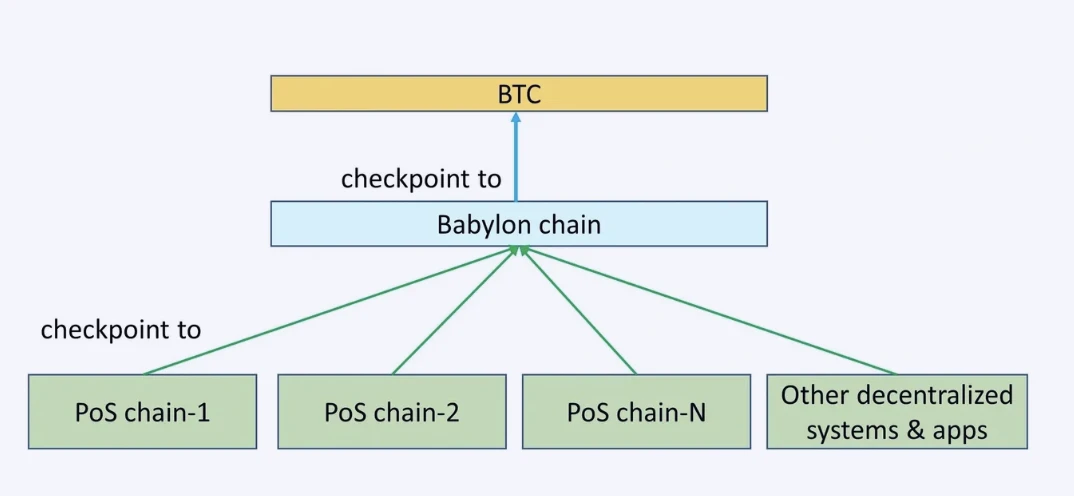
The architecture of Babylon is shown in the figure above. It consists of three parts and then has two levels of checkpoints:
Bitcoin, as a timestamping service layer;
Babylon chain (a chain built on Cosmos SDK) as the middle layer;
PoS blockchains that act as security consumers (e.g. other Cosmos zones);
An important design consideration is that the amount of data that Bitcoin can carry is very limited. In this context, the Babylon chain has multiple functions:
It aggregates the checkpoint streams of many PoS consumer chains, so only one checkpoint stream needs to be inserted into the Bitcoin network to timestamp events in all consumer PoS chains at the same time.
Its checkpoints in the Bitcoin network can be made compact using cryptographic techniques such as aggregate signatures.
It receives checkpoints from consumer PoS chains via the IBC protocol.
It checks the data availability of the checkpoints of the PoS consumer chain so that attackers cannot timestamp unavailable data.
This structure can help the Pos chain improve security, such as resisting long-range attacks.
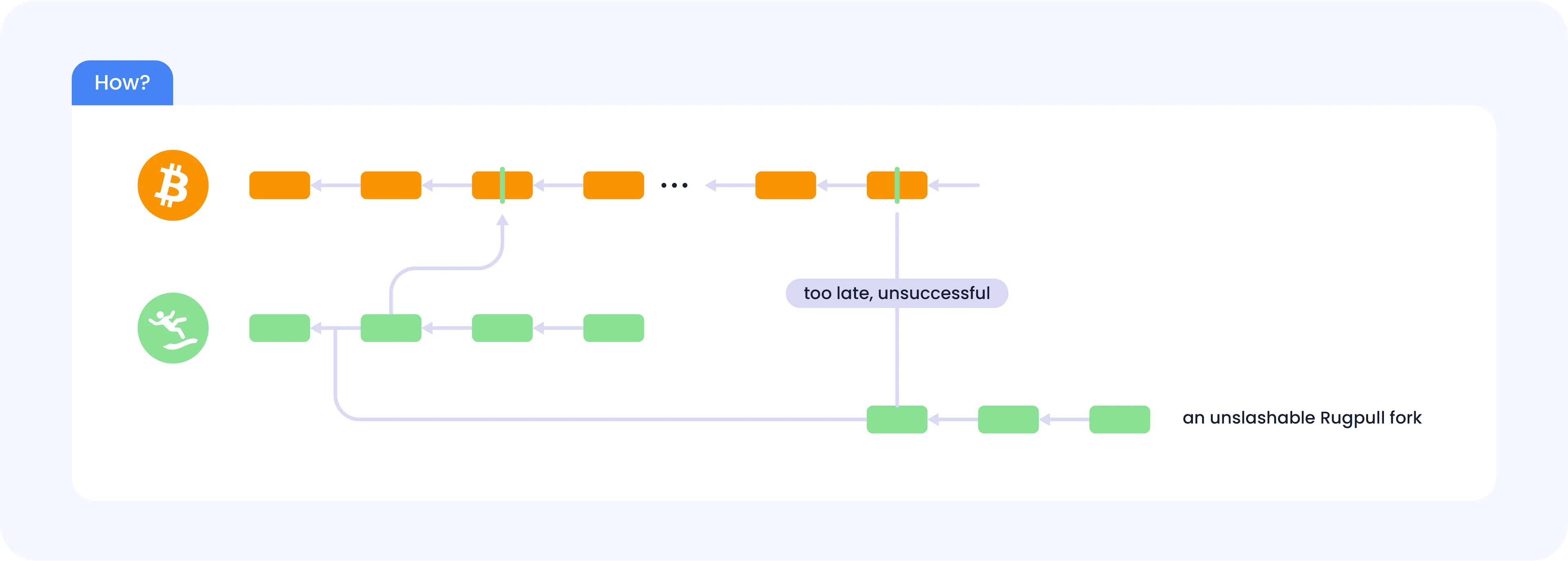
To protect the PoS chain from long-range attacks, we can send the block checkpoints of the PoS chain to BTC and select the fork with an earlier BTC timestamp as the legitimate fork. In this way, there are only two cases:
The attack fork will have a later timestamp in the BTC mainnet, and the fork will never be chosen by anyone, or
In order to be selected, the attacker would have to create a very long BTC fork where the attacked PoS fork had an earlier timestamp, which is economically impossible.
Therefore, long-range attacks can be offset by BTC timestamps.
In addition to resolving long-range attacks, the irreversible BTC timestamp of PoS blocks also provides other security advantages for PoS chains:
Eliminate weak subjectivity: Bitcoin timestamps are objective, which can eliminate the PoS chains reliance on social consensus and weak subjectivity.
Shorter unbinding time: By replacing social consensus, BTC timestamps can reduce the staking unbinding time of PoS chains from weeks to one day.
New chain bootstrapping: New PoS chains with lower valuations are more vulnerable to fork attacks. BTC timestamps can help protect the growth of the chain itself.
Verification of state synchronization and snapshots: The objective facts of the PoS chain provided by BTC allow users of the PoS chain to verify the chain state or snapshot downloaded from the P2P network.
Protecting important transactions: BTC timestamps can be used to further confirm important PoS transactions, but at the cost of longer confirmation delays.
Censorship resistance: BTC timestamping can also resist transaction censorship in PoS chains by publishing censored transactions to BTC.
Bitcoin Staking Protocol
Babylons Bitcoin staking protocol allows Bitcoin holders to stake Bitcoin without trusting any third party;
Without the need to bridge Bitcoin across the chain to the PoS chain, the PoS chain can be provided with the security guarantee of fully slashable staked rights.
Here is an example of Bitcoin staking:
Alice has a bitcoin and wants to stake it on a PoS chain. First, she sends a stake transaction
to the Bitcoin chain to enter a staking contract. The transaction is a Bitcoin that locks her Bitcoin into a self-custodial vault.
Transactions. The locked bitcoins can only be unlocked using Alices private key in one of the following two ways:
(1) Alice initiates an “unbonding transaction”, and the Bitcoin will be unlocked and returned to Alice within three days.
(2) Alice initiates a “slashing transaction” to send the bitcoin to the destruction address.
Once the staking transaction enters the Bitcoin chain, Alice can start signing blocks with her key to validate the PoS chain.
During her verification duties, there are two possible paths.
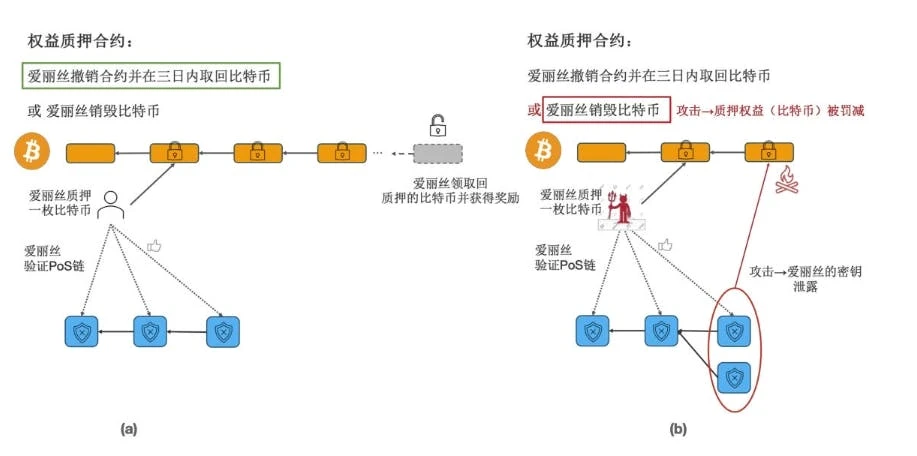
Source: https://docs.babylonchain.io/papers/btc_staking_litepaper(CN).pdf
One is the happy path (Figure (a) above), that is, Alice honestly follows the protocol, and when she wants to release the Bitcoin pledge, she initiates an unbinding request by sending an unbinding transaction to the Bitcoin chain (Figure (b) above). Once the unbinding transaction enters the Bitcoin chain, Alices verification obligation on the PoS chain ends, and three days later, Alice can withdraw and get back the Bitcoin. The PoS chain will also grant Alice a reward.
The second is the unhappy path (Figure (b) above), where Alice goes bad and participates in a double-spending attack on the PoS chain. In this case, the staking protocol ensures that Alices private key will be leaked to the public. Therefore, anyone can send a penalty reduction transaction to the Bitcoin chain as Alice and destroy Alices Bitcoin. The existence of this unhappy path ensures that the attacker will be punished, and this deterrence ensures that everyone takes the happy path - everyone operates normally.
Babylon uses extractable one-time signatures (EOTS) to reduce the penalty for malicious behavior. The core idea is that users can sign a message once, similar to a normal signature scheme. EOTS requires an additional tag parameter (the signature additional parameter is the block height when verifying a block). If a user tries to sign the same message twice with the same tag (signing two blocks at the same height), the users private key can be extracted from both signatures.
Compared
First of all, the structures of the Babylon protocol and EigenLayer are very different:
Babylon:

Babylon protocol structure diagram
EigenLayer:
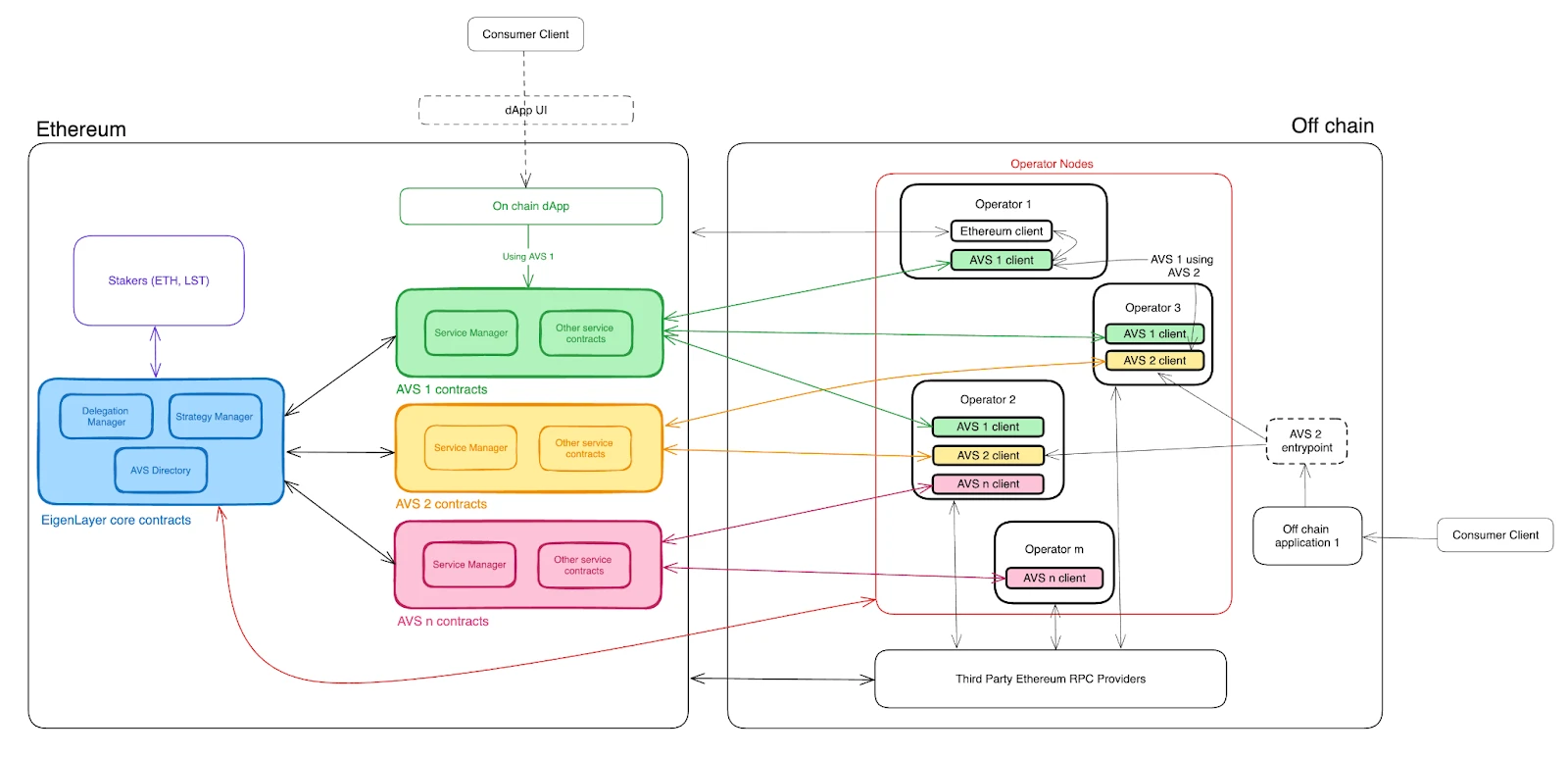
EigenLayer structure diagram
Babylon consists of two parts: the Bitcoin timestamp protocol and the pledge protocol. Since Bitcoin is not Turing complete, many processing tasks require a separate chain to complete. Therefore, the Babylon protocol has its own chain, which is built through the Cosmos SDK and has its own chain verification nodes. It also includes an independent EOTS Manager and Finality Provider.
EigenLayer is essentially composed of a set of smart contracts that can accept user pledges and manage AVS contracts, etc. The underlying layer is executed by the Ethereum network and its security is guaranteed.
Secondly, the two have different ways of achieving reductions.
Since Ethereum supports smart contract functions, the slashing logic implementation of EigenLayer will be written in the contract, and more complex slashing conditions can be implemented for different AVS. At the same time, if a situation cannot be resolved through predefined slashing conditions, there will be an off-chain veto committee to vote to resolve it.
However, due to the limitation of the function of Bitcoin mainnet, Babylon implements the slashing logic through EOTS. It has many restrictions and can only implement a relatively simple slashing logic for malicious situations of repeated signatures on blocks of the same height.
Due to the different ways of implementing the reduction, the service objects of the two are also different.
EigenLayer can implement complex slashing logic, which can provide security services for a wide range of AVS. For EigenLayer, its advantage lies in its consistency with Ethereum. Ethereum has the largest ecosystem in the cryptocurrency field, which means more users and greater demand. EigenLayers solution has the potential to address Ethereums limitations, such as the need for secure and decentralized bridges, data availability solutions, and decentralized sequence layers for Layer 2 solutions. Within the Ethereum ecosystem, using ETH as a pledge asset is considered a politically correct practice. Therefore, applications built around EigenLayer will be more applications that serve the Ethereum ecosystem.
Babylon mainly serves Pos chains, especially the chains of the Cosmos ecosystem, because the Bitcoin timestamp service needs to pass messages between the Babylon chain and the Cosmos chain through the IBC protocol, so it has great limitations. And these Pos chains require a separate set of verification nodes. Its advantage may be that the Cosmos ecosystem has now developed a large scale and produced a large number of excellent Pos chains, such as Celestia, Osmosis, Axelar, dYdX, etc., and these protocols can be easily connected to the Babylon chain to obtain the security of Bitcoin. The development of EigenLayer requires a large number of project parties to redevelop and adapt AVS, and the start will be in a backward stage. In addition, the solution of building an application chain through the Cosmos SDK has been verified by a lot of people, which may be more friendly to project development. Babylon also has certain advantages in this regard, that is, choosing to bring the Cosmos ecosystem into Bitcoin security protection.
This is also related to the development direction of Ethereum and Cosmos ecology. Ethereum ecology first built a huge security core, namely the Ethereum mainnet, and formed many Layer 2 on this basis, but the interconnectivity between Layer 2 has not yet been solved. The Cosmos ecology first solved the interconnectivity between different zones, but lacked a strong security core. The market value of Cosmos Hub is too low to bear, so it is natural to find a security core. Babylon is targeting this demand, thus bringing in BTC security. At the same time, EigenLayer also hopes to bring Ethereum security into the Cosmos ecology through cooperation. From the perspective of the underlying architecture, Babylons solution may be more suitable for the Cosmos ecology.
Summarize
Both the Babylon protocol and EigenLayer hope to unlock the security of Bitcoin and Ethereum networks for more applications in their own ways. However, due to the non-Turing-complete nature of Bitcoin, its ecological development lags far behind the Ethereum ecosystem. At the same time, Bitcoins asset issuance and second-layer network have also taken a different path from Ethereum. Therefore, the Babylon protocol and EigenLayer differ in technical architecture, reduction methods, and service objects. From the current point of view, both have their own fields of cultivation and have their own advantages in development. However, with the development of modular blockchains and the interconnection and integration of different ecosystems, the two may form a situation of mutual competition in the future, and no one will dominate.
References
https://twitter.com/E2mResearch/status/1783714279394586787
https://pmcrypto.xyz/blog/wtf-is-eigenlayer-and-babylon-cn
https://docs.eigenlayer.xyz/eigenlayer
https://docs.babylonchain.io/docs/introduction/overview
https://www.chaincatcher.com/article/2079486
About E2M Research
From the Earth to the Moon E 2 M Research focuses on research and learning in the fields of investment and digital currency.
Article collection: https://mirror.xyz/0x80894DE3D9110De7fd55885C83DeB3622503D13B
Follow us on Twitter: https://twitter.com/E2mResearch ️
Audio podcast: https://e2m-research.castos.com/
Xiaoyuzhou link: https://www.xiaoyuzhoufm.com/podcast/6499969a932f350aae20ec6d
DC Link: https://discord.gg/WSQBFmP772










